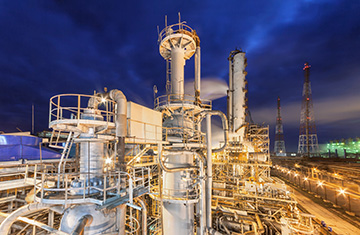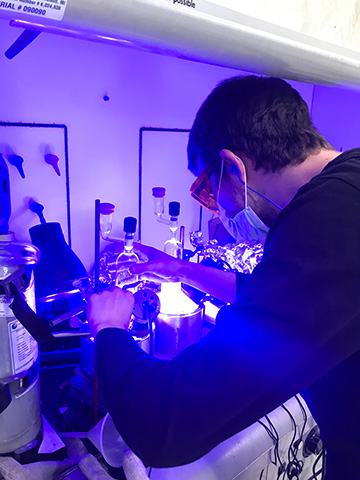
Conventional chemical plants for production of ammonia and nitrogen fertilizer, such as this one in Russia, use copious amounts of energy to drive nitrogen fixation. A team at Caltech has tested out a potentially far-lower-energy approach that uses light as the driving force. [Image: saoirse_2010 / Getty Images]
Any effort to “decarbonize” the world’s economies will need to come to grips with finding new ways to make ammonia—a substance essential to agricultural fertilizers, but one whose production consumes copious amounts of energy and fossil fuels. Researchers have thus been hard at work for years on a variety of ways to clean up ammonia synthesis. Those efforts have ranged from exploring renewable, carbon-neutral chemical feedstocks to testing various new approaches to the electrochemistry and catalysis used to assemble the ammonia molecule.
A team of researchers at the California Institute of Technology (Caltech), USA, now reports an advance in one such alternative approach—using light to drive the chemical reduction of atmospheric nitrogen that lies at the heart of ammonia production (Sci. Adv., doi: 10.1126/sciadv.ade3510). The finding, stresses research team leader Jonas Peters, is still at the “fundamental science” stage, and not ready for direct application. But it does offer interesting progress toward more sustainable production of an indispensable material as the world grapples with climate change.
An essential molecule
Making ammonia commercially involves “fixing” nitrogen by combining a nitrogen atom with three hydrogen atoms, to create the ammonia molecule, NH3. That would seem to be a simple prospect; after all, nitrogen, in the form N2, makes up some 78% of Earth’s atmosphere. But converting that stable, nonreactive atmospheric nitrogen into ammonia turns out to be a devilishly difficult chemical problem.
In the first decade of the 20th century, the German chemist Fritz Haber developed a lab-scale system for ammonia synthesis—a system that was subsequently bought by the German chemical firm BASF and scaled up to industrial production by one of the firm’s employees, the chemical engineer Carl Bosch. The resulting scheme—called, not surprisingly, the Haber–Bosch process—is arguably one of the most consequential scientific discoveries in history.
In particular, Haber–Bosch led to the widespread introduction of ammonia-based fertilizers, a significant factor in the huge growth of agricultural yields and world population in the intervening century. Around half of the world’s food production now reportedly relies on ammonia fertilizer. So important has ammonia production become to feeding the world that the energy scientist Vaclav Smil, in his recent book How the World Really Works, refers to ammonia as one of the “four material pillars of modern civilization.” (The other three he cites are plastics, steel and concrete.)
To tame an energy hog
The problem is that the Haber–Bosch process, while world-changing, has a prodigious appetite for energy. The International Energy Agency (IEA) estimates that at present, ammonia production—almost all of it still using the Haber–Bosch process—consumes some 2% of the world’s energy budget and accounts for around 1.3% of CO2 emissions. A large part of the energy cost comes from the use of methane (and the steam-reforming thereof) as the source of the hydrogen (H2) molecules used to fix atmospheric nitrogen. But another significant share comes from the very high temperatures and pressures needed to thermodynamically drive the Haber–Bosch process and create the ammonia molecule.

Study coauthor and Ph.D. student Christian Johansen at the lab bench. The team used blue-light irradiation to drive the catalytic formation of ammonia from atmospheric nitrogen at room temperature and pressure. [Image: J.C. Peters]
The work of the Caltech team—which includes Peters along with grad students Christian Johansen and Emily Boyd—looks mainly at the second issue: how to lower the energy requirements for driving the actual assembly of the NH3 molecule from stable nitrogen and hydrogen. And the team thinks there’s promise in letting light serve as the driving force.
The process begins by replacing H2, as the hydrogen donor, with a so-called Hantzsch ester—a specific organic molecule that stores the equivalent of H2 in two hydrogen atoms. In these esters, photons of blue light can loosen the bonding of the hydrogen atoms in the organic molecule. Thus blue light can, in principle, make the hydrogen atoms available to link up with nitrogen atoms and create NH3, in the presence of a suitable catalyst to speed up the reaction.
Using light from blue LEDs and a common molybdenum-bromine catalyst, the team found that it could coax significant ammonia yields, on the order of 25%, using the Hantzch ester and N2, and an even higher 73% when nitrate (NO3) was used instead of N2 as the source of nitrogen atoms. A still better performance came when an additional Ir-containing photoredox catalyst was added to the mix.
Most important, perhaps, the light-driven reaction takes place at room temperature and pressure. That’s potentially far more energetically favorable than the steep heating and pressure requirements to drive the conventional Haber–Bosch process.
Next steps toward practical application
In an email to OPN, team leader Jonas Peters stressed that the recently reported work constitutes a “basic science” discovery. “It would definitely be putting the cart in front of the horse,” he wrote, “to credibly discuss real-world applications at this stage.”
One particular issue that would need to be addressed is how to efficiently recycle the remaining organic Hantzsch ester molecule after it has been photocatalytically stripped of its hydrogen atoms to feed the ammonia synthesis. One possibility, Peters said, would be “electroreduction in the presence of a proton source, which in an ideal world would come from water.”
Figuring out this recycling will be an important next step for the team toward a more practical system. “Unless one establishes the ‘recycling’ part of the chemistry, one really can’t do a direct comparison with Haber–Bosch (if the methane steam reforming to get the H2 is included),” according to Peters. The team would also, he says, like to look beyond just blue light to drive the reaction. “In terms of net energy this system is very favorable, as the driving force comes from available sunlight,” he told OPN. “But we’d like to use a broader envelope of visible light in the future.”
Still, the team’s work marks one interesting research pathway toward more sustainable ammonia production. And while it is unlikely to provide a complete solution, Peters notes that using light to drive the reaction “has some obvious practical attraction.” For example, he suggests, it could eventually open up the prospect of ammonia production in smaller-scale, more distributed facilities, rather than large centralized plants.
